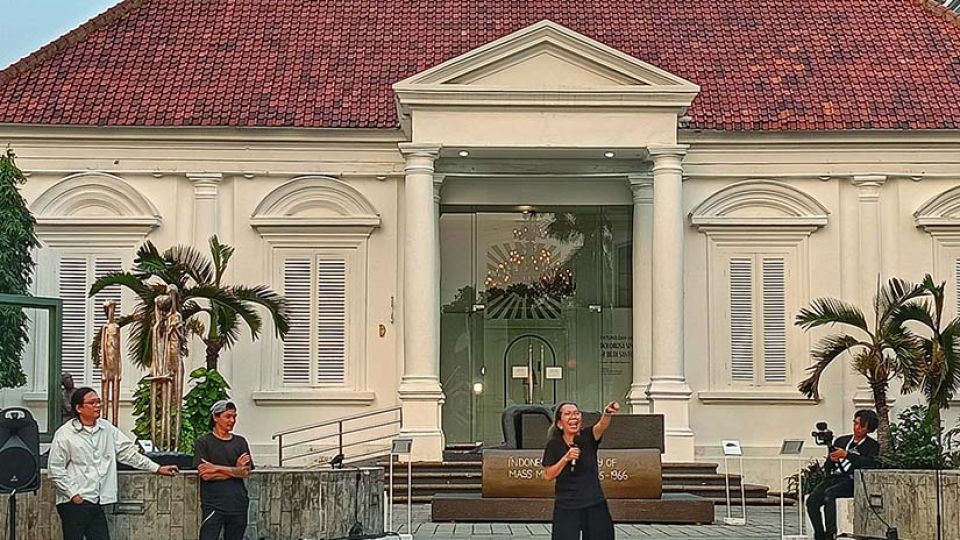August 14, 2024
JAKARTA – Art does not always capture the beauty of our world for the enjoyment of the audience. Sometimes, art also pokes at our neatly dressed wounds and rips the bandages off.
Such are the works presented by Indonesian sculptor Dolorosa Sinaga and her former protégé, Budi Santoso. Their joint exhibition, titled “Statues and Activism”, delves into Indonesia’s turbulent history, as well as today’s problems.
“Their works encourage us to question the things we’re afraid to question ourselves,” said Alexander Supartono, curator of the exhibition, during a press tour on July 19.
The exhibition, which runs in Building A of the National Gallery until Aug. 19, showcases over 200 works by the two artists.
Sociopolitical activism
In front of the main building, just below its white marble steps, a thin man slumps over a coffin atop a thick book titled Indonesian History of Mass Murder 1965-1966, his wide-open mouth seemingly uttering a silent scream.
This poignant fiberglass sculpture by Dolorosa speaks volumes about the 1965-1966 atrocities committed to suppress what is believed to be a rebellion by the Indonesian Communist Party.
Next to it stands Monumen Penghilangan Paksa di Indonesia (Monument of Kidnappings in Indonesia, 2024), also by Dolorosa, featuring a massive hollow photo frame supported by an elderly man and woman.
This powerful piece reflects the countless men and women who disappeared after voicing concerns against the New Order regime, with the transparent oblong photo frame echoing their painful absence.
“During street rallies, the families always carry a photo of their loved ones [who went missing],” Alexander said.
“Dolo [Dolorosa’s nickname] knows this firsthand, as she frequently joins their protests.”
Dolorosa is one of Indonesia’s most prominent female sculptors.
At 72, she is an acclaimed artist, human-rights activist and lecturer. One of the first graduates of the Jakarta Arts Institute (IKJ) in 1977, she later studied at St. Martins School of Art in London, learning directly from renowned British sculptors, including Anthony Caro and Phillip King.
“I believe Dolo possesses one of the best understandings of figurative anatomy among Indonesian sculptors,” the curator emphasized.
In the early 1990s, amid increased repression by the New Order regime, Dolorosa became active in street rallies and protests.
Her works also increasingly reflected her concerns for human rights.
“She has become a pioneer among Indonesian artists in using art for social change and inspiring others to follow in her footsteps,” Alexander said.
In 2000, Dolorosa met Budi Santoso during a street rally in Jakarta.
“There’s an almost 30-year age gap between us, and yet we have a lot in common,” Dolorosa said.
Budi, born in Cilacap in 1980, was an art student at the Indonesia Institute of Arts (ISI) in Yogyakarta and is a member of the socio-politically charged art collective Taring Padi.
“[My friends and I] spent the night at Dolorosa’s house and visited her studio,” Budi said.
“I was wowed by her works and proposed to apprentice at her studio.”
Budi was accepted, beginning a relationship that spanned over two decades, evolving from apprentice to assistant, colleague and good friend.
“If it were just a teacher-student relationship, there would surely come a time when the student would leave because he’s learned enough,” Alexander said.
“But Dolorosa and Budi share the same soul, which is why they can work together as equals.”
Budi now lives in Yogyakarta with his wife and five-year-old daughter, working in his own art studio, Manualism.
Reliving shadows of the past
One of Budi’s most striking pieces in the exhibition is Anatomi Kerja (Work Anatomy, 2023), which is inspired by anthropometric photos taken by a German doctor researching tropical skin diseases among plantation workers in South Sumatra in 1882.
“Anthropometric photography was a racist practice, as it classified humans based on their physical traits,” the curator said.
The doctor photographed each worker nude, documenting their names, origins and measurements.
Budi has transformed these photos into iron, aluminum and teak statuettes, each depicting a worker standing precariously on top of their working tools.
Just across from this piece is a tall, slender figure of a woman, her hair styled in a traditional bun and wearing a golden kebaya (traditional blouse). A large chain drapes from her neck down along her torso.
The iron statue, titled I, the Witness (2024), is Dolorosa’s portrayal of Ita Martadinata Haryono.
Ita, who was raped during the May 1998 riots, was murdered in her own bedroom just a week before she was scheduled to testify at the United Nations headquarters in New York.
“I’ve especially revived her in this statue to bear witness to her story,” Dolorosa said, with a sad smile.
Many visitors on the opening night appeared transfixed by the 2.3-meter-tall statue.
“This exhibition is crucial as it documents numerous human rights violations in our country,” said Uchikowati, chairwoman of the Dialita Choir, when interviewed on the opening night.
Addressing contemporary issues
The exhibition does not just dwell on the past. Budi also addresses current global issues with his work.
His metal-and-resin statue, Dialog Dengan Tuhan (Dialogue with God, 2024), featuring three little girls looking up at the sky, reflects his concerns about today’s ongoing wars and genocide.
“The piece was inspired by my five-year-old daughter’s question: ‘If God is love, why are there still so many wars in this world?'” the artist explained.
Another piece, Historical Moment (2024), shows a woman reading a book to her child on a window ledge.
“Many young children in my village in a remote area of Yogyakarta are already addicted to gadgets,” Budi said. “It’s a dangerous trend as it keeps them passively consuming whatever is on their screens, whereas books are the true windows to the world.”
Both artists hoped the exhibition would ignite conversations and inspire people to work together toward the betterment of the country.
“Art is love,” Dolorosa said. “And love is the power that can truly change the world.”


